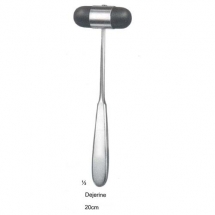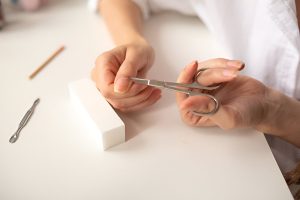The Dejerine Reflex Hammer with Needle is a specialized neurological examination tool used by healthcare professionals, particularly neurologists and physiotherapists, to assess the reflexes and sensory responses of a patient’s nervous system. This tool is an enhanced version of the standard reflex hammer, adding a needle feature to help with certain diagnostic procedures. Here’s a breakdown of its purpose, design, and usage:
What is a Dejerine Reflex Hammer with Needle?

The Dejerine Reflex Hammer is designed to test the deep tendon reflexes, also known as muscle stretch reflexes, which are an essential part of neurological assessment. Reflexes like the patellar reflex (knee jerk) or Achilles reflex help assess the integrity of the nervous system, particularly the spinal cord and peripheral nerves.
The “with needle” feature refers to a thin, sharp needle integrated into the hammer, usually in the form of a retractable or fixed needle in the handle. This added component allows the hammer to perform additional functions beyond basic reflex testing.
Key Components of the Dejerine Reflex Hammer with Needle
The Hammer Head
The hammer head is typically made of rubber or plastic and is designed to provide a quick, percussive strike when tapped on the patient’s tendons. The head can be weighted or non-weighted, depending on the design, but it is primarily used for eliciting reflex responses.
The Handle
The handle is typically made of metal or plastic, with a comfortable grip that allows the clinician to hold and manipulate the hammer during testing. The needle is housed within or along the handle, often retracting when not in use.
The Needle
The needle integrated into the Dejerine Reflex Hammer is often used for more advanced diagnostic purposes, such as testing sensory responses or performing small, controlled skin pricks to assess neurological functions. The needle can be used to test tactile sensation, pain perception, or the integrity of the sensory nerves.
Purpose and Function
Reflex Testing
- The primary purpose of the Dejerine Reflex Hammer is to test deep tendon reflexes, such as the patellar, Achilles, and biceps reflexes. When the hammer is struck against the tendon, it stretches the muscle and stimulates a reflex arc, causing a muscle contraction that the clinician can observe. The response helps assess the function of the associated nerve and spinal cord segment.
Sensory Testing with the Needle
- The needle feature of the Dejerine Reflex Hammer can be used to perform small puncture tests or to elicit a response from the sensory system. By gently pricking the skin with the needle, the clinician can assess a patient’s response to light touch, pain, or temperature changes. This test is particularly useful in assessing the function of sensory nerves and detecting conditions like neuropathy or nerve damage.
Differentiating Reflex Responses
- In some neurological assessments, the reflex hammer is used to assess the presence or absence of specific reflexes, such as the plantar reflex or the Babinski reflex. The needle function allows for a more thorough sensory examination, helping clinicians differentiate between different types of neurological dysfunctions.
Common Clinical Uses
Neurological Examination
- The Dejerine Reflex Hammer with Needle is commonly used during routine neurological exams. It helps assess the overall health and function of a patient’s nervous system, providing insight into the integrity of the spinal cord, peripheral nerves, and reflex arcs.
Testing for Nerve Damage
- When testing for nerve damage or neuropathy, the reflex hammer with needle allows clinicians to evaluate both motor and sensory responses. This tool is often used when a patient presents with symptoms like weakness, numbness, or pain in specific areas of the body.
Assessing Reflex Symmetry
- Reflex symmetry (or asymmetry) is an important diagnostic feature. The Dejerine Reflex Hammer with Needle enables clinicians to test reflexes on both sides of the body, helping identify any abnormalities that might indicate neurological disorders such as multiple sclerosis, stroke, or spinal cord injury.
Evaluating Deep Tendon Reflexes in Comatose Patients
- In cases where patients are unconscious or in a coma, the reflex hammer is used to assess the brainstem and spinal reflexes to gauge the depth of coma and neurological function. The needle can help assess pain sensation and responses in unconscious patients.
Conclusion
The Dejerine Reflex Hammer with Needle is a valuable diagnostic tool in neurology, allowing healthcare professionals to assess both reflex and sensory responses in patients. Its ability to perform detailed neurological examinations, particularly in cases of nerve damage or dysfunction, makes it a crucial instrument for diagnosing and monitoring a range of neurological conditions. Whether for routine exams or more complex assessments, the Dejerine Reflex Hammer with Needle provides versatility, precision, and convenience, helping clinicians deliver accurate diagnoses and optimal care for their patients.




